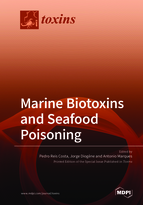Marine Biotoxins and Seafood Poisoning
A special issue of Toxins (ISSN 2072-6651). This special issue belongs to the section "Marine and Freshwater Toxins".
Deadline for manuscript submissions: closed (30 June 2019) | Viewed by 48183
Special Issue Editors
Interests: harmful algal blooms; marine toxins
Special Issues, Collections and Topics in MDPI journals
Interests: climate change and chemical contaminants in seafood; contaminant levels and toxicity of contaminants in seafood; consumer risks and benefits; mitigation strategies to reduce contaminant levels in seafood
Special Issues, Collections and Topics in MDPI journals
Special Issue Information
Dear Colleagues,
Worldwide, mollusks and fish may be contaminated by marine toxins (MT) due to the seasonal presence of marine-toxin-producing microalgae. The prevalence of MT has increased globally and the occurrence of MT in temperate regions of tropical areas is nowadays a reality, likely due to climate change. Epidemiological studies are scarce and risk characterization is needed, particularly for emerging toxins. In addition, the economic burden to seafood producers caused by the closure of production areas and insecurity urges the implementation of fast screening tools and the development of predictive modeling tools for stakeholders. Therefore, it is critical to enhance collaborative multi and trans disciplinary actions to introduce innovative strategies to improve shellfish and fish safety and to strengthen industrial competitiveness by developing sensor devices for MT detection and implementing mitigation strategies through processing. Innovative toxicological approaches for seafood safety evaluation are also requested.
Dr. Pedro Reis Costa
Dr. Jorge Diogène
Dr. Antonio Marques
Guest Editors
Manuscript Submission Information
Manuscripts should be submitted online at www.mdpi.com by registering and logging in to this website. Once you are registered, click here to go to the submission form. Manuscripts can be submitted until the deadline. All submissions that pass pre-check are peer-reviewed. Accepted papers will be published continuously in the journal (as soon as accepted) and will be listed together on the special issue website. Research articles, review articles as well as short communications are invited. For planned papers, a title and short abstract (about 100 words) can be sent to the Editorial Office for announcement on this website.
Submitted manuscripts should not have been published previously, nor be under consideration for publication elsewhere (except conference proceedings papers). All manuscripts are thoroughly refereed through a double-blind peer-review process. A guide for authors and other relevant information for submission of manuscripts is available on the Instructions for Authors page. Toxins is an international peer-reviewed open access monthly journal published by MDPI.
Please visit the Instructions for Authors page before submitting a manuscript. The Article Processing Charge (APC) for publication in this open access journal is 2700 CHF (Swiss Francs). Submitted papers should be well formatted and use good English. Authors may use MDPI's English editing service prior to publication or during author revisions.
Keywords
- Ciguatoxins
- Tetrodotoxins
- PSPs
- DSPs
- ASPs
- fast screening methods
- climate change
- epidemiology
- risk characterization
- bio-accessibility/cooking








